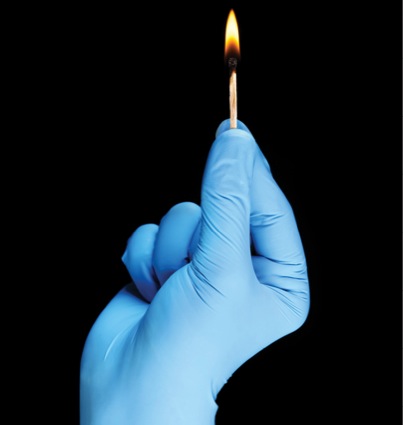A lifelong Buddhist with a daily meditation practice, Sharmila Dissanaike, MD, a professor and the chair of surgery at Texas Tech University Health Sciences Center, in Lubbock, is often invited to speak to physicians about meditation and other mindfulness techniques in order to reduce their risk for burnout. She declines.
The burnout plaguing half of U.S. physicians will not be eradicated by training more doctors in meditation, she said.
Her belief: Burnout has grown out of dysfunctions in today’s health care delivery systems—not from physicians’ lack of self-care. Those dysfunctions, she said, are structural. So they need structural solutions.
Dr. Dissanaike wants change initiated at the top levels of surgery and spread throughout organizations.
“I feel strongly that the onus is on the surgical leadership, on institutional leadership to make changes to reduce burnout. It should not devolve towards trying to improve physician wellness, although that’s a laudable goal for separate reasons.”
At a presentation during the 2019 annual meeting of the Eastern Association for the Surgery of Trauma, Dr. Dissanaike made a case for systemwide changes to buffer against burnout. Improving physician resilience is too often hailed as the antidote to burnout, she said. But it’s not enough. Rather, she believes that leaders in health care should focus on reducing the administrative burden on physicians and increasing flexibility in work environments, allowing physicians to focus on patient care.
At Texas Tech, Dr. Dissanaike introduced policies to give surgeons and support staff more flexibility. In-house, 24-hour trauma call was replaced with a shift work model so surgeons no longer do a full night of call before working the next day. More flexible work schedules are permitted: Surgeons can compress their work commitments into a two-week schedule from four, allowing them two weeks of free time to travel more, do overseas work, or spend more time with their families. And surgeon compensation was restructured. Bonuses are no longer linked primarily to clinical productivity but also account for contributions in education and research.
Dr. Dissanaike hasn’t formally tracked burnout among her colleagues in the shadow of these changes. Burnout is not easy to monitor, nor easy to fix. It is not a medical diagnosis, but a syndrome that grows from exhaustion, cynicism and decreased effectiveness at work. However, she sees surgeons who are less exhausted from covering trauma call and happier to have free time outside of work.
Dr. Dissanaike wants to create a culture that values physicians as people, not just health care providers. “One of the antidotes against burnout is physicians finding meaning in their work and enjoying the interpersonal connections it affords because one of the hallmarks of burnout is depersonalization.”
Her approach is backed by research exploring burnout in health care. The evidence favors interventions that are directed across an organization rather than at the physician level (JAMA Intern Med 2017;177[2]:195-205). In a meta-analysis of studies on burnout published in 2017, investigators concluded that “burnout is a problem of the whole health care organization, rather than individuals.” The report was based on 19 studies with a total of 1,500 physicians, although the overall quality of studies was poor.
Current estimates suggest that the prevalence of burnout among practicing physicians in the United States exceeds 50%. Emergency medicine, general internal medicine, neurology and family medicine had the highest rates of burnout, whereas pathology, dermatology, general pediatrics and preventive medicine, including occupational health and environmental medicine, have the lowest (Arch Intern Med 2012;172[18]:1377-1385).
Burnout was a major topic at this year’s EAST meeting where surgeons presented personal experiences and various approaches on how to deal with it.
As he delivered the Oriens Keynote Address, Andrew B. Peitzman, MD, the Mark M. Ravitch Professor of Surgery, University of Pittsburgh, said work–life balance is a challenge for every surgeon throughout his or her career. His advice: What works for one surgeon will not work for everyone—each must make their own family and career decisions based on their goals.
In the past, surgical departments failed to recognize that different surgeons will weigh their priorities differently, he said. But they can no longer do so. He urged surgical leaders to acknowledge that colleagues and trainees are not all aiming for the same career and family achievements. Encourage surgeons to practice in the ways that keep them passionate about their work, and the result will be surgeons who are happier, with more meaningful relationships at and outside of work, and less prone to burnout, he said.
“We need to acknowledge that there is really no such thing as a sweet spot for everybody. We each have to find our own and realize it. Because when we make decisions about our careers and families, there will be consequences.”
He talked about the stress that a surgical career can place on marriage and personal relationships. “Marriage can drift apart insidiously if people don’t pay attention. Remember why you got married, and make sure you still pay attention and do all the things that helped you get married in the first place.”
Dr. Peitzman concluded his talk by highlighting the things he wished he’d known when he started: Always take the high ground; do not fight for turf, but fight for better patient care; 90% of the battles at work are unimportant, so do not engage; and discern the 10% that are important and fully engage. He reminded surgeons that self-doubt is normal and encouraged them seek out a mentor.
“Make time ideally every day for personal time. And it’s not golfing. I mention that because spending hours on a golf course is not great for your family and probably not the best for you.”


